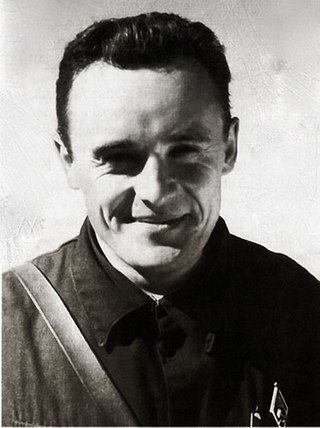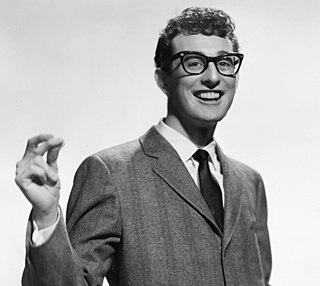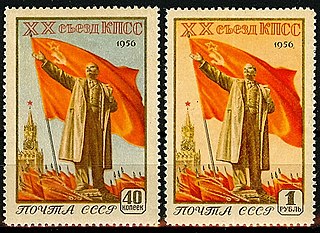| |||||
| Decades: | |||||
|---|---|---|---|---|---|
| See also: | |||||
The following lists events that happened during 1959 in the Union of Soviet Socialist Republics .
| |||||
| Decades: | |||||
|---|---|---|---|---|---|
| See also: | |||||
The following lists events that happened during 1959 in the Union of Soviet Socialist Republics .

The Cuban Missile Crisis, also known as the October Crisis in Cuba, or the Missile Scare, was a 13-day confrontation between the United States and the Soviet Union, when American deployments of nuclear missiles in Italy and Turkey were matched by Soviet deployments of nuclear missiles in Cuba. The crisis lasted from October 16 to October 28, 1962. The confrontation is widely considered the closest the Cold War came to escalating into full-scale nuclear war.

Nikita Sergeyevich Khrushchev was the First Secretary of the Communist Party of the Soviet Union from 1953 to 1964, and Chairman of the Council of Ministers (premier) from 1958 to 1964. During his rule, Khrushchev stunned the communist world with his denunciation of his predecessor Joseph Stalin's crimes, and embarked on a policy of de-Stalinization with his key ally Anastas Mikoyan. He sponsored the early Soviet space program and the enactment of moderate reforms in domestic policy. After some false starts, and a narrowly avoided nuclear war over Cuba, he conducted successful negotiations with the United States to reduce Cold War tensions. In 1964, the Kremlin leadership stripped him of power, replacing him with Leonid Brezhnev as First Secretary and Alexei Kosygin as Premier.

Sergei Pavlovich Korolev was a lead Soviet rocket engineer Ukrainian origin, and spacecraft designer during the Space Race between the United States and the Soviet Union in the 1950s and 1960s. He is regarded by many as the father of practical astronautics. He was involved in the development of the R-7 Rocket, Sputnik 1, launching Laika, Sputnik 3, the first human-made object to make contact with another celestial body, Belka and Strelka, the first human being, Yuri Gagarin, into space, Voskhod 1, and the first person, Alexei Leonov, to conduct a spacewalk.

On 1 May 1960, a United States U-2 spy plane was shot down by the Soviet Air Defence Forces while conducting photographic aerial reconnaissance deep inside Soviet territory. The single-seat aircraft, flown by American pilot Francis Gary Powers, had taken off from Peshawar, Pakistan, and crashed near Sverdlovsk, after being hit by an S-75 Dvina surface-to-air missile. Powers parachuted to the ground safely and was captured.

Anastas Ivanovich Mikoyan was an Armenian Communist revolutionary, Old Bolshevik and Soviet statesman. Having been elected to the Central Committee in 1923, he was the only Soviet politician who managed to remain at the highest levels of power within the Communist Party from the latter days of Lenin, through the eras of Stalin and Khrushchev, to his peaceful retirement under Brezhnev.

The Cold War (1953–1962) discusses the period within the Cold War from the end of the Korean War in 1953 to the Cuban Missile Crisis in 1962. Following the death of Joseph Stalin earlier in 1953, new leaders attempted to "de-Stalinize" the Soviet Union causing unrest in the Eastern Bloc and members of the Warsaw Pact. In spite of this there was a calming of international tensions, the evidence of which can be seen in the signing of the Austrian State Treaty reuniting Austria, and the Geneva Accords ending fighting in Indochina. However, this period of good happenings was only partial with an expensive arms race continuing during the period and a less alarming, but very expensive space race occurring between the two superpowers as well. The addition of African countries to the stage of cold war, such as the Democratic Republic of the Congo joining the Soviets, caused even more unrest in the West.

The Kitchen Debate was a series of impromptu exchanges through interpreters between U.S. Vice President Richard Nixon, then 46, and Chairman of the Council of Ministers Nikita Khrushchev, 65, at the opening of the American National Exhibition at Sokolniki Park in Moscow on July 24, 1959.

The following events occurred in May 1960:
In the United States, during the Cold War, the missile gap was the perceived superiority of the number and power of the USSR's missiles in comparison with those of the U.S.. The gap in the ballistic missile arsenals did not exist except in exaggerated estimates, made by the Gaither Committee in 1957 and in United States Air Force (USAF) figures. Even the contradictory CIA figures for the USSR's weaponry, which showed a clear advantage for the US, were far above the actual count. Like the bomber gap of only a few years earlier, it was soon demonstrated that the gap was entirely fictional.

After the establishment of diplomatic ties with the Soviet Union after the Cuban Revolution of 1959, Cuba became increasingly dependent on Soviet markets and military aid and was an ally of the Soviet Union during the Cold War. In 1972 Cuba joined the COMECON, an economic organization of states designed to create co-operation among the communist planned economies, which was dominated by its largest economy, the Soviet Union. Moscow kept in regular contact with Havana and shared varying close relations until the end of the Soviet Union in 1991. Cuba then entered an era of serious economic hardship, the Special Period.

The following events occurred in January 1959:

The following events occurred in February 1959:

The following events occurred in September 1959:

The Khrushchev Thaw is the period from the mid-1950s to the mid-1960s when repression and censorship in the Soviet Union were relaxed due to Nikita Khrushchev's policies of de-Stalinization and peaceful coexistence with other nations. The term was coined after Ilya Ehrenburg's 1954 novel The Thaw ("Оттепель"), sensational for its time.
"On the Cult of Personality and Its Consequences", popularly known as the "Secret Speech", was a report by Soviet leader Nikita Khrushchev, First Secretary of the Communist Party of the Soviet Union, made to the 20th Congress of the Communist Party of the Soviet Union on 25 February 1956. Khrushchev's speech was sharply critical of the rule of the deceased General Secretary and Premier Joseph Stalin, particularly with respect to the purges which had especially marked the last years of the 1930s. Khrushchev charged Stalin with having fostered a leadership cult of personality despite ostensibly maintaining support for the ideals of communism. The speech was leaked to the West by the Israeli intelligence agency Shin Bet, which received it from the Polish-Jewish journalist Wiktor Grajewski.

The 20th Congress of the Communist Party of the Soviet Union was held during the period 14–25 February 1956. It is known especially for First Secretary Nikita Khrushchev's "Secret Speech", which denounced the personality cult and dictatorship of Joseph Stalin.

The Syrian Crisis of 1957 was a period of severe diplomatic confrontations during the Cold War that involved Syria and the Soviet Union on one hand, and the United States and its allies, including Turkey and the Baghdad Pact, on the other.
The following lists events that happened during 1959 in Germany.

The state visit of Nikita Khrushchev to the United States was a 13-day visit from 15–27 September 1959. It marked the first state visit of a Soviet or Russian leader to the US. Nikita Khrushchev, then First Secretary of the Communist Party of the Soviet Union and Chairman of the Council of Ministers, was also the first leader of the Soviet Union to set foot in the Western Hemisphere. Being the first visit by a leader of his kind, the coverage of it resulted in an extended media circus.
The following is a timeline of the presidency of John F. Kennedy from his inauguration as the 35th president of the United States on January 20, 1961, to December 31, 1961.